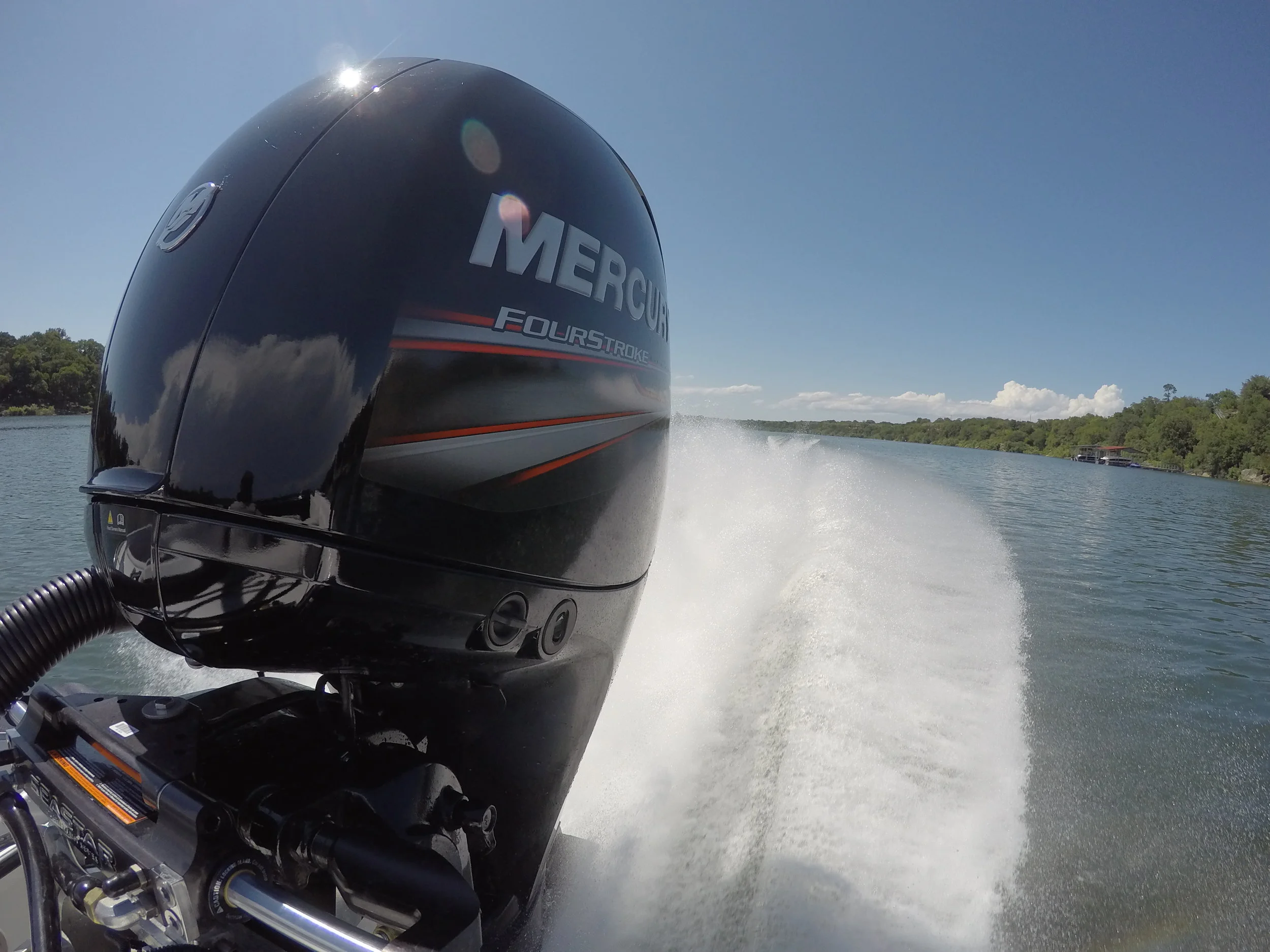Mercury 150 Four Stroke: ProXS Motor Mount Install and Details
Although we've done some testing and talked about the Allison Grand Sport quite a bit, we haven't examined the features of the 150 Mercury four stroke too closely, and we wanted to show the ProXS motor mount install.
Our 150 four stroke is very closely related to the 150 ProXS, which makes 5 more HP, at 200 more RPM. The Pro version also has a 4.88 gearcase with low water pickup, which is attractive on its own. But, when you do the math, the gear ratio difference really makes the ProXS a difficult proposition. It's a great engine, the 4 cylinder single overhead cam, but that extra 5 HP is lost with the 2.08 gear ratio found on the Pro. Effectively, you nullify the advantages of the higher rev limiter, by gearing down.
On a boat like the Allison Grand Sport, the difference is pronounced. In fact, I would say our 150 would be faster than a ProXS because of this. On a heavier slower boat, it might be closer. An advantage of the Pro is the upper mounts. By using a stiffer rubber compound, they are a slight improvement over the base 150. We swapped our stock upper mounts out for the Pro mounts, it is a really easy job that is not expensive. If you remove the cowl, and side cowl, you have full access to the upper and lower mounts. Some older engines were a pain to change, because you had to lift the powerhead to access the top mounts.
Here is a side by side of the ProXS mount, and regular mount on the right. Virtually no visual difference, and the lower mounts on all the 150 Mercury’s are the same. Those aren’t my hands.
Although the improvement is small, I feel it's worth it. The natural next step is to get actual solid ones machined. This will be costly, but it's probably worth it. Why do I complain about mounts all the time? Solid mounts are essential to making your steering precise. Without them, the soft mounts allow the engine to wobble back and forth. All hydraulic steering has a little bit of play, so the combination of hydraulic steering, and soft rubber mounts, translates to sloppy steering. This makes it difficult to handle the boat as it goes faster, causing chine walking, and other poor handling characteristics.
With the cowling and side cowling removed, the mounts are easy to access. The right and left mount are different, so make sure you don’t mix them up.
Engine manufacturers obsess over noise and vibration now, but to the detriment of the performance of the boat. Plus, soft mounts will wear out faster. Balancing a boat on the pad, and the feel through steering is important. Additionally, you can see boats with soft mounts running in rough water and the engines will be bouncing all over the place. This puts unnecessary strain on the transom, steering and other parts. Having 500 Lbs bouncing around on your transom is not a good thing.
I will probably choose Delrin, a super durable plastic, and retain the rubber gaskets, which will allow sufficient vibration absorption. Most new engines are so smooth, it won't be a problem at all. Most people run solid metal mounts on old two strokes and it's not a problem. Mercury Racing is pretty much the only manufacturer with a firm handle on this, as all of their outboards have solid mounts. It's a huge competitive advantage.
Let's shift back to the gears. If we consider the gears strictly from a mathematical standpoint, it's easy to see how critical they are to performance. I think outboard manufacturers were worried about four strokes not being able to match the low end punch of two strokes, and made a general decision to use lower gears in order to address this. But, the latest generation of four strokes are quite powerful, and don't really give up anything in torque. But, here is why that logic is faulty. The propeller is a constant variable, with the pitch being theoretical because of slip. The reduction gear means if you have a 2.00:1 ratio, and you max RPM is 6,000, you’re turning the prop 3,000 RPM. In my case, I can rev up to 5940 RPM / 1.92 ratio = 3,093.75 RPM on the prop. The Mercury 150 ProXS revs to slightly over 6,000 RPM, let’s say 6,100 / 2.08:1 = 2,932.69. So, even with the extra RPM up top, you won’t be faster, because all else being equal, you won’t be able to turn the same prop faster.
The incredible mileage the Mercury 150 Four Stroke achieves is partly the engine, but mostly the hull. Our gears are decent, at 1.92:1, but higher gears would even make it more efficient, allowing a lower pitch prop.
To compensate for the gears, you need to add pitch, when you add pitch, you lose efficiency. I’m running a 28” ProMax propeller on the limiter, and can turn a 30” at just over 5600 RPM, and should be able to get it 100 or 200 more by raising my engine more. I would much rather have 1.85 or 1.75 gears on the 150, and run less pitch; that way I’d have improved low end acceleration, higher top speed, and have improved prop efficiency. This is the variable manufacturers overlook, the advantage or taller gears (lower numeric) is you can run lower pitch. Even on a slower boat, a lower pitch is just easier to turn. For example, if you were trying to pull 3 people up on skis at one time, you would choose the lowest pitch prop possible.
As much as I like the Mercury Racing 4.6L V8 platform, I still think there is a market for the lighter and sleeker V6 and 4 cyl platforms to have “R” versions. Personally, on anything light and small, I like all the 4 cylinder engines, the Mercury 150 and 115, the Yamaha Vmax 4 cylinder, and now the Evinrude G2 3 cylinder.
A few clever design features of the Mercury Four Stroke 150 are the simple winterizing and maintenance access. You can change your own oil and filter very easily, flushing is done with a simple hose connector, you can flush without the engine running. The powerhead is slightly off axis, in order to make the cowling slightly narrower, making it one of the more compact 150’s on the market. Mercury went with a single overhead cam design for a few reasons, fewer parts mean it can be slightly lighter, with less failure points. A timing chain makes for stress free and maintenance free operation. As well, a SOHC can make loads of low end torque, and the 3.0L 150 Merc does make plenty of torque.
I love this engine, a few adjustments to the ProXS version, like the higher gears, and improved mounts, would make it the best 150 HP outboard on the market without question. Ours is essentially a ProXS minus the ECU change. We bought ours as a Certified Pre-Owned from Mercury Marine, where you get a full warranty for one year, on an engine that was inspected and reconditioned. This ends up being a great deal, especially if you want to make some of the improvements like we did.
Performance Report: Mileage
30” ProMax:
35 MPH at 2700 RPM = 11.7 MPG
50 MPH at 3500 RPM = 8.7 MPG
58 MPH at 4100 RPM = 8 MPG
28” ProMax:
42 MPH at 3200 RPM = 10.5 MPG
48 MPH at 3600 RPM = 9.3 MPG
62 MPH at 4600 RPM = 7 MPG
26” Trophy Plus (Allison Cut):
50 MPH at 3800 RPM = 8 MPG
59 MPH at 4800 RPM = 6.9 MPG
65 MPH at 5200 RPM = 6.4
The 28” ProMax prop is the best all around prop so far, even though it hits the rev limiter at 77 MPH, it gets incredible mileage, handles great and can do it all.











